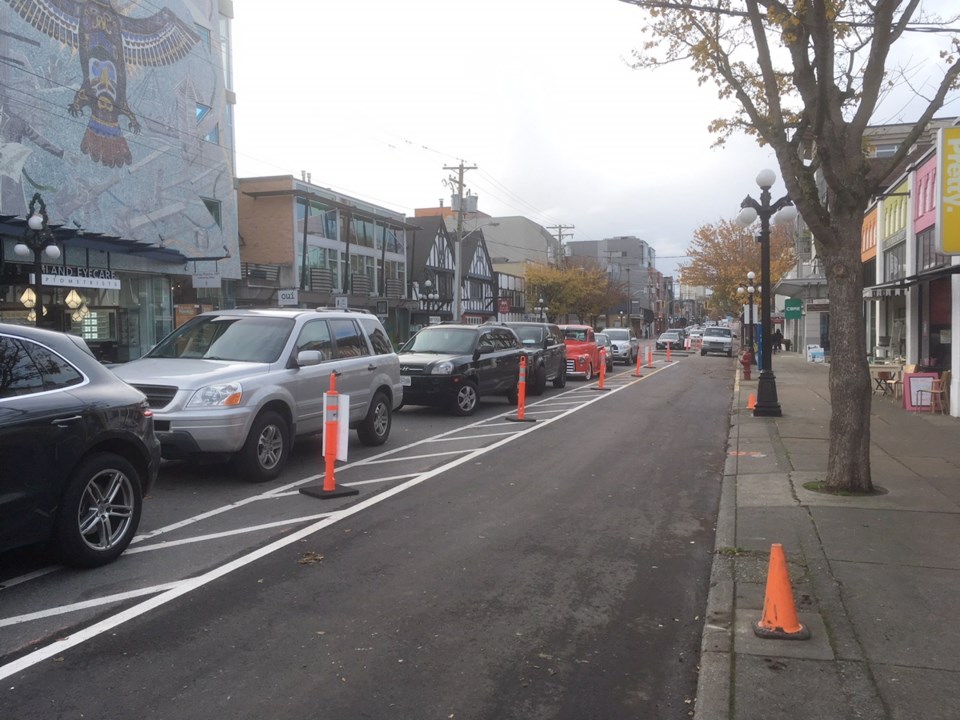Update: Victoria councillors gave the green light Thursday to spending another $3 million to complete the first phase of the city’s protected bike lane network. Read the full story here
Another $3 million is needed to complete the first phase of Victoria’s separated bike lane network, city staff say.
The latest cost estimates are that $7.85 million is needed to complete the Wharf, Humboldt and Cook street segments of the project, says a report from city staff. About $4.86 million is already available.
Based on figures in the staff report, that would push first- phase costs to an estimated $14.5 million — almost $2.7 million a kilometre, and about double the $7.75 million the city initially set aside. The project includes 5.4 kilometres of separated all-ages-and-abilities downtown bike lanes.
Mayor Lisa Helps said she supports the increase.
“The $7.75 million wasn’t a budget, it was the money that was allocated initially,” she said.
Much of the additional cost arises from implementing suggestions made through public consultation, Helps said, citing Fort Street as an example.
“We’re putting in an extra $500,000 to save eight parking spots in the 600 block of Fort Street. That was [due to] direct input from the public. That impacts the costs.”
Fraser Work, the city’s director of engineering, said staff have yet to come up with a refined cost estimate for the entire 32-kilometre network, but it would not be accurate to extrapolate the per-kilometre downtown cost to outer areas.
Costs are going to “change drastically in the right direction” when the bike network moves out of downtown, Work said.
“As soon as you get out of the downtown, you have much, much lower costs for every corridor,” he said. “You just don’t have that same level of complexity below you, above you and beside you.”
Several factors are driving up spending, including construction market cost escalations of between 25 and 30 per cent.
The scope of the project has also expanded to include the likes of signal upgrades, pedestrian improvements, on-street parking, loading zone requirements and public space improvements.
Phase one of the bike network includes:
• Protected two-way bike lanes on Pandora Avenue and Fort Street between Cook and Wharf streets.
• Protected two-way bike lanes on the west side of Wharf between the Johnson Street Bridge and Government Street.
• Protected two-way bike lanes on the south side of Humboldt Street between Government and Douglas streets, and shared road use between Douglas and Cook.
• One-way protected bike lanes on both sides of Cook Street between Pandora and Pakington Street.
The report notes that, when conceived, rough estimates put the cost of the Pandora bike lane at about $2.09 million and the Fort Street bike lane at $2 million. Pandora ended up costing $3.42 million (of which $900,000 was for changes in project scope).
Fort Street, being built now, is projected to cost $3.27 million (of which $524,400 is for scope changes and $191,000 is a contingency).
Wharf, originally conceived as an $800,000 project, increases to $1.46 million when scope changes and contingencies are added, and to $2.26 million when market adjustment and construction contingency, detailed design and administration are included.
Humboldt was to be $600,000. It will increase to $1.13 million with scope changes and contingencies, and to $1.76 million when market adjustments and contingencies, detailed design and administration are included.
Cook Street, originally $1.30 million, increases to $2.37 million for scope changes and contingencies, and to $3.68 million when market factors, contingencies, detailed design and administration fees are added.
The first phase of the bike network was originally to be completed by the end of 2018.
If the increases are approved, staff estimate construction of the Wharf, Humboldt and Cook Street bike facilities could begin in August 2018 with completion in the first quarter of 2019.
Staff recommend the additional money that’s needed come primarily from gas tax grants, with about $75,000 from “found money” in the engineering budget due to staff vacancies.



